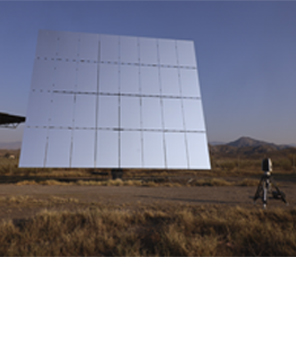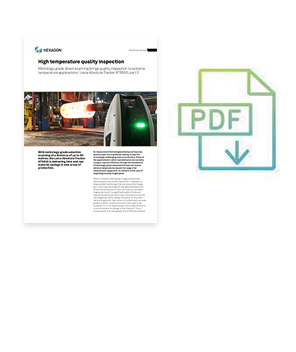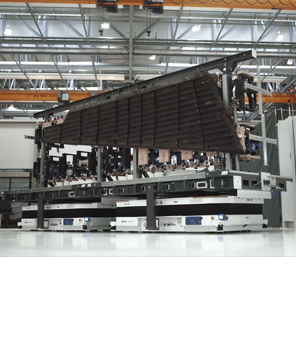Inspección de calidad a altas temperaturas
Con un escaneo selectivo de grado metrológico a una distancia de hasta 60 metros, el Leica Absolute Tracker ATS600 ofrece ahorros de tiempo y materia prima en nuevas áreas de producción

Artículo técnico - Leica Absolute Tracker ATS600, parte 2
Conforme las tecnologías de medición se desarrollan y mejoran, la inspección de la calidad se abre camino gradualmente en áreas de producción cada vez más complejas. Algunas de las aplicaciones en las cuales los fabricantes están tratando de mejorar la eficiencia a través de la introducción de herramientas de medición de grado metrológico incluyen temperaturas extremas fuera del alcance de todos los equipos de medición, por ejemplo en el caso de inspección de piezas recién forjadas.
 Cuando se trata de la forja de grandes componentes, existen algunas razones de peso para invertir en una tecnología de medición que pueda garantizar que la pieza fundida sea lo más cercana posible a las dimensiones de la pieza final. Por un lado, una forja sobredimensionada puede resultar en un desperdicio considerable de tiempo y material ya que se requiere de un mecanizado excesivo para que la pieza forjada quede dentro de la tolerancia del diseño. Por otro lado, una pieza forjada que se obtiene de tamaño menor es un problema aún mayor, ya que puede ser necesario desechar toda la pieza si no es lo suficientemente grande en una sola dimensión para adaptarla al diseño de la pieza final. Por supuesto que esto resulta en una pérdida de tiempo y material aún mayor.
Cuando se trata de la forja de grandes componentes, existen algunas razones de peso para invertir en una tecnología de medición que pueda garantizar que la pieza fundida sea lo más cercana posible a las dimensiones de la pieza final. Por un lado, una forja sobredimensionada puede resultar en un desperdicio considerable de tiempo y material ya que se requiere de un mecanizado excesivo para que la pieza forjada quede dentro de la tolerancia del diseño. Por otro lado, una pieza forjada que se obtiene de tamaño menor es un problema aún mayor, ya que puede ser necesario desechar toda la pieza si no es lo suficientemente grande en una sola dimensión para adaptarla al diseño de la pieza final. Por supuesto que esto resulta en una pérdida de tiempo y material aún mayor.
La inspección dimensional es la respuesta natural a este desafío, pero es un proceso difícil cuando se involucran temperaturas extremas – las herramientas típicas de la metrología simplemente no son capaces de soportar las temperaturas de 1000°C que se registran en la forja de grandes piezas metálicas.
El Leica Absolute Tracker ATS600 es un innovador láser tracker que ofrece una solución a este problema a través de su función de escaneo directo a gran distancia.
La función de escaneo directo es una característica que permite al tracker medir puntos en una superficie desde una distancia de hasta 60 metros con una precisión en el rango de decenas de milímetros.
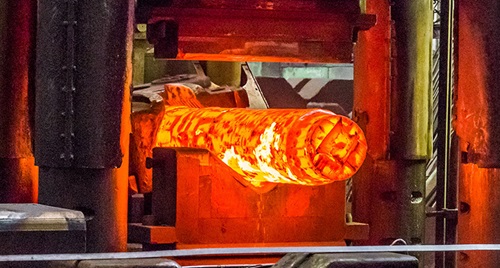 A esta distancia de la pieza caliente, la temperatura extrema no es problema para el ATS600, y con una precisión en las piezas calientes mantenida a niveles submilimétrico, las piezas pueden forjarse directamente a un tamaño mucho más cercano a las dimensiones finales requeridas de lo que suele ser posible.
A esta distancia de la pieza caliente, la temperatura extrema no es problema para el ATS600, y con una precisión en las piezas calientes mantenida a niveles submilimétrico, las piezas pueden forjarse directamente a un tamaño mucho más cercano a las dimensiones finales requeridas de lo que suele ser posible.
Esta función de escaneo directo es exclusiva del ATS600 entre los láser trackers. Es similar al escaneo hemisférico realizada por los escáneres láser terrestres para fines topográficos, pero con una precisión significativamente mayor y con la capacidad de apuntar hacia áreas de medición más pequeñas con escaneo selectivo, en vez de obtener datos de una zona más amplia que posteriormente deben filtrarse. El ATS600 también puede ofrecer resultados inmediatos gracias a su incorporación con procesos de software de metrología estándar, que permiten la comparación directa de los valores dimensionales reales con los nominales.
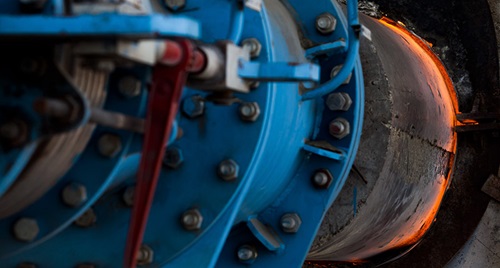 La forja no es la única aplicación en la que las altas temperaturas causan problemas para efectuar mediciones precisas. En la industria cementera, la alineación del horno es una tarea regular crucial. La mala alineación del horno de cemento puede provocar fuerzas excesivas que desgastan componentes como engranajes, cojinetes, anillos de rodadura y rodillos. Esto puede provocar averías muy costosas mucho antes de que se alcance la vida útil prevista del horno.
La forja no es la única aplicación en la que las altas temperaturas causan problemas para efectuar mediciones precisas. En la industria cementera, la alineación del horno es una tarea regular crucial. La mala alineación del horno de cemento puede provocar fuerzas excesivas que desgastan componentes como engranajes, cojinetes, anillos de rodadura y rodillos. Esto puede provocar averías muy costosas mucho antes de que se alcance la vida útil prevista del horno.
E incluso antes del fallo, la mala alineación del horno de cemento puede dar lugar a un proceso ineficiente que cueste más tiempo y recursos de los necesarios. La etapa del horno es la que más energía consume y más gases de efecto invernadero produce en el proceso de fabricación del cemento, por lo que cualquier mejora de la eficiencia es muy apreciada en el sector.
Por lo tanto, la alineación es muy importante, pero no por ello es sencilla. Esto se debe a las elevadas temperaturas que se alcanzan durante la fase de piroprocesado en la fabricación de cemento hidráulico: en determinados momentos del proceso, el horno alcanza temperaturas de hasta 1450°C.
 Una vez más, el ATS600 y su función de escaneo directo ofrecen una solución gracias a la capacidad de medir un área seleccionada con precisión y a distancia. Cuando el horno se calienta, no es posible colocar reflectores o señales de puntería a lo largo del cilindro para comprobar y corregir la alineación.
Una vez más, el ATS600 y su función de escaneo directo ofrecen una solución gracias a la capacidad de medir un área seleccionada con precisión y a distancia. Cuando el horno se calienta, no es posible colocar reflectores o señales de puntería a lo largo del cilindro para comprobar y corregir la alineación.
Con el uso de los modos Panorama Imaging y Line Scan del ATS600, un solo usuario puede realizar una medición sencilla y rápida únicamente de las zonas del horno necesarias para definir la alineación, lo que permite realizar comprobaciones de alineación muy regulares que garantizan una alta eficiencia y reducen el desgaste innecesario.
Desde el lanzamiento del ATS600 en 2019 se han ido descubriendo nuevas áreas de producción en las que se puede aplicar de forma útil el escaneo directo en una amplia gama de industrias. A medida que los ingenieros de calidad y producción se familiaricen con esta innovadora tecnología de metrología, no cabe duda de que pronto se descubrirán muchas más aplicaciones interesantes.
 Cuando se trata de la forja de grandes componentes, existen algunas razones de peso para invertir en una tecnología de medición que pueda garantizar que la pieza fundida sea lo más cercana posible a las dimensiones de la pieza final. Por un lado, una forja sobredimensionada puede resultar en un desperdicio considerable de tiempo y material ya que se requiere de un mecanizado excesivo para que la pieza forjada quede dentro de la tolerancia del diseño. Por otro lado, una pieza forjada que se obtiene de tamaño menor es un problema aún mayor, ya que puede ser necesario desechar toda la pieza si no es lo suficientemente grande en una sola dimensión para adaptarla al diseño de la pieza final. Por supuesto que esto resulta en una pérdida de tiempo y material aún mayor.
Cuando se trata de la forja de grandes componentes, existen algunas razones de peso para invertir en una tecnología de medición que pueda garantizar que la pieza fundida sea lo más cercana posible a las dimensiones de la pieza final. Por un lado, una forja sobredimensionada puede resultar en un desperdicio considerable de tiempo y material ya que se requiere de un mecanizado excesivo para que la pieza forjada quede dentro de la tolerancia del diseño. Por otro lado, una pieza forjada que se obtiene de tamaño menor es un problema aún mayor, ya que puede ser necesario desechar toda la pieza si no es lo suficientemente grande en una sola dimensión para adaptarla al diseño de la pieza final. Por supuesto que esto resulta en una pérdida de tiempo y material aún mayor.La inspección dimensional es la respuesta natural a este desafío, pero es un proceso difícil cuando se involucran temperaturas extremas – las herramientas típicas de la metrología simplemente no son capaces de soportar las temperaturas de 1000°C que se registran en la forja de grandes piezas metálicas.
El Leica Absolute Tracker ATS600 es un innovador láser tracker que ofrece una solución a este problema a través de su función de escaneo directo a gran distancia.
La función de escaneo directo es una característica que permite al tracker medir puntos en una superficie desde una distancia de hasta 60 metros con una precisión en el rango de decenas de milímetros.
 A esta distancia de la pieza caliente, la temperatura extrema no es problema para el ATS600, y con una precisión en las piezas calientes mantenida a niveles submilimétrico, las piezas pueden forjarse directamente a un tamaño mucho más cercano a las dimensiones finales requeridas de lo que suele ser posible.
A esta distancia de la pieza caliente, la temperatura extrema no es problema para el ATS600, y con una precisión en las piezas calientes mantenida a niveles submilimétrico, las piezas pueden forjarse directamente a un tamaño mucho más cercano a las dimensiones finales requeridas de lo que suele ser posible.Esta función de escaneo directo es exclusiva del ATS600 entre los láser trackers. Es similar al escaneo hemisférico realizada por los escáneres láser terrestres para fines topográficos, pero con una precisión significativamente mayor y con la capacidad de apuntar hacia áreas de medición más pequeñas con escaneo selectivo, en vez de obtener datos de una zona más amplia que posteriormente deben filtrarse. El ATS600 también puede ofrecer resultados inmediatos gracias a su incorporación con procesos de software de metrología estándar, que permiten la comparación directa de los valores dimensionales reales con los nominales.
 La forja no es la única aplicación en la que las altas temperaturas causan problemas para efectuar mediciones precisas. En la industria cementera, la alineación del horno es una tarea regular crucial. La mala alineación del horno de cemento puede provocar fuerzas excesivas que desgastan componentes como engranajes, cojinetes, anillos de rodadura y rodillos. Esto puede provocar averías muy costosas mucho antes de que se alcance la vida útil prevista del horno.
La forja no es la única aplicación en la que las altas temperaturas causan problemas para efectuar mediciones precisas. En la industria cementera, la alineación del horno es una tarea regular crucial. La mala alineación del horno de cemento puede provocar fuerzas excesivas que desgastan componentes como engranajes, cojinetes, anillos de rodadura y rodillos. Esto puede provocar averías muy costosas mucho antes de que se alcance la vida útil prevista del horno.E incluso antes del fallo, la mala alineación del horno de cemento puede dar lugar a un proceso ineficiente que cueste más tiempo y recursos de los necesarios. La etapa del horno es la que más energía consume y más gases de efecto invernadero produce en el proceso de fabricación del cemento, por lo que cualquier mejora de la eficiencia es muy apreciada en el sector.
Por lo tanto, la alineación es muy importante, pero no por ello es sencilla. Esto se debe a las elevadas temperaturas que se alcanzan durante la fase de piroprocesado en la fabricación de cemento hidráulico: en determinados momentos del proceso, el horno alcanza temperaturas de hasta 1450°C.
 Una vez más, el ATS600 y su función de escaneo directo ofrecen una solución gracias a la capacidad de medir un área seleccionada con precisión y a distancia. Cuando el horno se calienta, no es posible colocar reflectores o señales de puntería a lo largo del cilindro para comprobar y corregir la alineación.
Una vez más, el ATS600 y su función de escaneo directo ofrecen una solución gracias a la capacidad de medir un área seleccionada con precisión y a distancia. Cuando el horno se calienta, no es posible colocar reflectores o señales de puntería a lo largo del cilindro para comprobar y corregir la alineación.Con el uso de los modos Panorama Imaging y Line Scan del ATS600, un solo usuario puede realizar una medición sencilla y rápida únicamente de las zonas del horno necesarias para definir la alineación, lo que permite realizar comprobaciones de alineación muy regulares que garantizan una alta eficiencia y reducen el desgaste innecesario.
Desde el lanzamiento del ATS600 en 2019 se han ido descubriendo nuevas áreas de producción en las que se puede aplicar de forma útil el escaneo directo en una amplia gama de industrias. A medida que los ingenieros de calidad y producción se familiaricen con esta innovadora tecnología de metrología, no cabe duda de que pronto se descubrirán muchas más aplicaciones interesantes.
